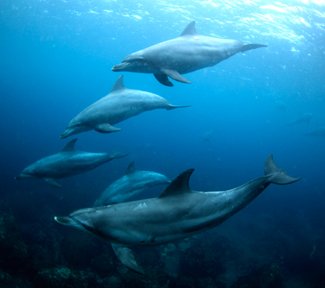Dolphins get the girl with help from mates

EVEN DOLPHINS SEE THE benefit of social networking when it comes to finding a mate.
Male Indo-Pacific bottlenose dolphins that form alliances with other mates are more likely to get the girl, a new Australian study has shown.
“We found that only a small proportion of males in the population were successful at reproducing,” says study author Jo Wiszniewski, a marine biologist at Macquarie University in Sydney. “Most of these males that were successful were part of alliances.”
Dolphin wingmen best for success
The study focused on populations of dolphins living in Port Stephens, 200km north of Sydney. To identify paternity and understand the social structures that might influence reproductive success in this population, researchers took DNA samples and observed the population over a period of eight years.
In the Port Stephens dolphin population, researchers found that alliances formed between two to four males. Surprisingly, the size of an alliance played a role in a member’s chance of securing a mate.
“The larger the alliance is, the more successful the males are at reproducing,” Jo says.
Dolphin mates stick together like family
Members of an alliance typically spend up to 80-90 per cent of their time together and behave more like a group of friends than a hierarchical unit.
“Each of the males within the alliance had roughly the same number of calves – that means there’s not one dominant male in the alliance,” Jo says. “They realise they can’t do it alone and need the help of others.”
This friendly behaviour was surprising, Jo says, because alliances typically include males that are unrelated to one another.
“That’s actually quite fascinating,” Jo says. “It means that their relationships are based on high-level cooperation and, I guess, [they] trust that their actions will be reciprocated.”
Teamwork ensures mating success
Indo-Pacific bottlenose dolphins are not the only mammals that form similar social networks; chimpanzees and lions, for example, have been known to ensure reproductive success by cooperating in groups. Previous research has also shown that dolphins are better mothers when they have assistance from other females.
“It’s not surprising, but it’s an important result,” says Daniele Cagnazzi, a marine biologist from Southern Cross University. “It definitely gives more information about how dolphin societies work.”
Daniele, who studies a population of dolphins that live in Queensland’s coastal waters, says the tendency to form alliances within a community – and also seek mates within the same community – may be a detriment to dolphin populations already under stress.
“If the local population decreases in size and these interactions to extend the community do not happen, then you may have problems,” Daniele says.
But the social alliances uncovered in the study are not necessarily found in all dolphins. A variety of factors – including food scarcity, predation risk, and even the openness of a population’s environment – may influence the social structures dolphins form.
“Their social behaviour really depends on their ecological environment,” Jo says.
The study was published this month in the Journal of Animal Ecology.
RELATED STORIES

